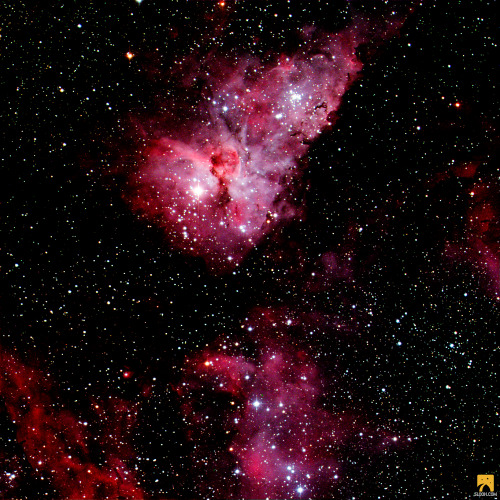Mola Walk

mola walk
More Posts from Mystarypi and Others


the pixel art //// the sticker follow me on twitter / instagram / patreon / shop / leave a tip
One of my favorite nebulae ♥♥♥ It looks so beautiful 🥰🥰🥰

NGC 6357: Cathedral to Massive Stars via NASA https://ift.tt/31D4Lqn
How massive can a normal star be? Estimates made from distance, brightness and standard solar models had given one star in the open cluster Pismis 24 over 200 times the mass of our Sun, making it one of the most massive stars known. This star is the brightest object located just above the gas front in the featured image. Close inspection of images taken with the Hubble Space Telescope, however, have shown that Pismis 24-1 derives its brilliant luminosity not from a single star but from three at least. Component stars would still remain near 100 solar masses, making them among the more massive stars currently on record. Toward the bottom of the image, stars are still forming in the associated emission nebula NGC 6357. Appearing perhaps like a Gothic cathedral, energetic stars near the center appear to be breaking out and illuminating a spectacular cocoon.
(Published August 30, 2020)



Experimented with cool and warm colours :) 💙







♡ STUDIO GHIBLI + favorite quotes ♡


Unborn.
–
Twitter / Shop / INPRNT / Patreon

Milky Way at Dawesville, Western Australia
Nikon d5500 - 85mm - ISO 3200 - f/2.5 - Foreground: 18 x 30 seconds - Sky: 61 x 30 seconds - iOptron SkyTracker

This is the Trifid Nebula! 🎀🎀🎀
With its name meaning “divided into 3 lobes”, this close-up picture shows the stellar beauty of this star-forming region. Containing an open cluster, emission nebula, reflection nebula, and a dark nebula, the Trifid Nebula is one of the most unique nebulae that makes it a common target for astronomers! 💖💖💖
Taken by me (Michelle Park) using the Slooh Chile Two telescope on June 12th, 2021 at 1:47 UTC.

This is the Eta Carinae Nebula! ✨✨✨
Due to its eruption in the 1840s, the mass of this stunning nebula has been challenging to measure. The colorful dust also dims the star’s ultraviolet and visible light by reradiating the shorter, more energetic light through longer wavelengths like infrared light! ❤❤❤
Taken by me (Michelle Park) using the Slooh Canary Two telescope on February 1st, 2022 at 5:32 UTC.
-
 pearlycomplaints liked this · 4 months ago
pearlycomplaints liked this · 4 months ago -
 ladycandy111 liked this · 9 months ago
ladycandy111 liked this · 9 months ago -
 thealienufo liked this · 10 months ago
thealienufo liked this · 10 months ago -
 jellynautical liked this · 1 year ago
jellynautical liked this · 1 year ago -
 8venusflytrap8 liked this · 1 year ago
8venusflytrap8 liked this · 1 year ago -
 fallenpine reblogged this · 1 year ago
fallenpine reblogged this · 1 year ago -
 softfiction liked this · 2 years ago
softfiction liked this · 2 years ago -
 yes-and-a-posible-no liked this · 2 years ago
yes-and-a-posible-no liked this · 2 years ago -
 archerist-ashuri liked this · 2 years ago
archerist-ashuri liked this · 2 years ago -
 ikuroi-sama liked this · 2 years ago
ikuroi-sama liked this · 2 years ago -
 paulaz liked this · 2 years ago
paulaz liked this · 2 years ago -
 easiepeas liked this · 2 years ago
easiepeas liked this · 2 years ago -
 sylvidaen liked this · 2 years ago
sylvidaen liked this · 2 years ago -
 pechikarondo liked this · 2 years ago
pechikarondo liked this · 2 years ago -
 lovekittenz reblogged this · 2 years ago
lovekittenz reblogged this · 2 years ago -
 marialdoza reblogged this · 2 years ago
marialdoza reblogged this · 2 years ago -
 nightheavy liked this · 3 years ago
nightheavy liked this · 3 years ago -
 khey-s reblogged this · 3 years ago
khey-s reblogged this · 3 years ago -
 khey-s liked this · 3 years ago
khey-s liked this · 3 years ago -
 buruuue reblogged this · 3 years ago
buruuue reblogged this · 3 years ago -
 anxioznogovno liked this · 3 years ago
anxioznogovno liked this · 3 years ago -
 princess-adrienne liked this · 3 years ago
princess-adrienne liked this · 3 years ago -
 sliceofdyke liked this · 3 years ago
sliceofdyke liked this · 3 years ago -
 arcsonara liked this · 3 years ago
arcsonara liked this · 3 years ago -
 polly-bee reblogged this · 3 years ago
polly-bee reblogged this · 3 years ago -
 regenbogenblut liked this · 3 years ago
regenbogenblut liked this · 3 years ago -
 moonmilkandthesea liked this · 3 years ago
moonmilkandthesea liked this · 3 years ago -
 angeliquevdn liked this · 3 years ago
angeliquevdn liked this · 3 years ago -
 bananashortcake liked this · 3 years ago
bananashortcake liked this · 3 years ago -
 darkrose517 liked this · 3 years ago
darkrose517 liked this · 3 years ago -
 darkrose517 reblogged this · 3 years ago
darkrose517 reblogged this · 3 years ago -
 latestagejenga liked this · 3 years ago
latestagejenga liked this · 3 years ago -
 i-regret-somethings liked this · 3 years ago
i-regret-somethings liked this · 3 years ago -
 nzkzdi liked this · 3 years ago
nzkzdi liked this · 3 years ago -
 icegwen liked this · 3 years ago
icegwen liked this · 3 years ago -
 danielgirl15 reblogged this · 3 years ago
danielgirl15 reblogged this · 3 years ago -
 soft-for-xie-lian liked this · 3 years ago
soft-for-xie-lian liked this · 3 years ago -
 paintedfaces2 liked this · 3 years ago
paintedfaces2 liked this · 3 years ago -
 greeneyedreader reblogged this · 3 years ago
greeneyedreader reblogged this · 3 years ago -
 the-freckled-luba liked this · 3 years ago
the-freckled-luba liked this · 3 years ago -
 lovenottrauma reblogged this · 3 years ago
lovenottrauma reblogged this · 3 years ago -
 warmbreadbuns liked this · 4 years ago
warmbreadbuns liked this · 4 years ago -
 garveth-c liked this · 4 years ago
garveth-c liked this · 4 years ago -
 little-illustrations reblogged this · 4 years ago
little-illustrations reblogged this · 4 years ago -
 kindgato reblogged this · 4 years ago
kindgato reblogged this · 4 years ago
